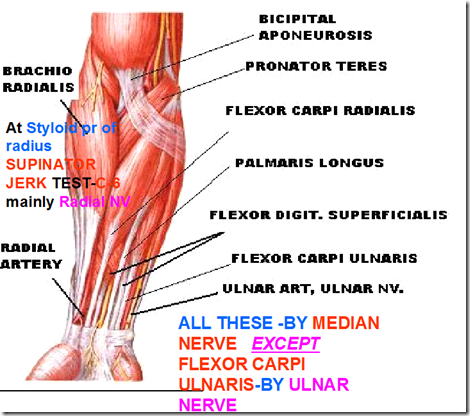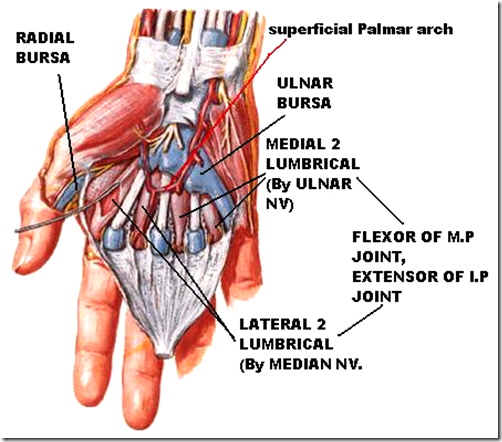CREDITS TO DR. NILESH KUMAR MITRA (Anatomy lecturer – International Medical University). His lecture notes is one of the sources I use for my blog posts and he is the best anatomy lecturer I’ve ever known. His efforts to educate and guide medical students in IMU will always be appreciated, by myself and all my colleagues that he has taught. THANK YOU!
*Read from written notes before reading from this post.
Naming of muscles
- Location
- Sternocleidomastoid
- Supraspinatus
- Heads of origins
- Biceps
- Triceps
- Action
- Flexor digitorum superficialis
- Flexor digitorum profundus
- Shape
- Orbicularis oculi
General Principles of muscles
- Origin
- fixed end
- Insertion
- moving end
- Tendon
- tough band of fibrous connective tissue
- connects muscle to bone
- capable of withstanding tension
- Aponeuresis
- layers of flat broad tendons
Classification of skeletal muscles – direction of fibres
- Parallel (range of movement more)
- strap
- quadrate
- fusiform
- Pennate (force of contraction more)
- unipennate
- bipennate
- multipenate
Actions of muscles
- Prime mover
- group of muscles that directly bring about desired movement
- Antagonist
- oppose the desired movement
- help prime mover by active relaxation
- Law of reciprocal innervation
- controls synergism
- opposite actions
- regulated by spinal cord segments (via stretch reflex)
- Fixators (Synergists)
- group of muscles which stabilise proximal joint of a limb
- so that prime move can effeciently move distal joints
- eg. if long flexors of forearm produce flexion of finger, extensors contract to fix wrist joints (proximal)
| Movement | Spinal segment | Prime mover | Antagonist |
| Flexion of elbow | C5, C6 | Biceps | Triceps |
| Extension of elbow | C7, C8 | Triceps | Biceps |
| Extension of knee | L3, L4 | Quadriceps | Hamstring |
| Flexion of knee | L5, S1 | Hamstring | Quadriceps |
_____________________________________________________________
MUSCLES
Muscles of the back (acting on shoulder)
- Trapezius
- from superior nuchal line
- runs along
- ligamentum nuchae
- from C7- T12
- runs along
- Insertion
- upper
- to clavicle
- elevate scapula
- 11th cranial nerve
- middle
- acromion
- retraction
- lower
- spine of scapula
- depress scapula
- upper
- from superior nuchal line
- Latissimus dorsi
- large muscle
- attached to humerus
- Function
- extersor of shoulder
- adductor of shoulder
Muscles of pectoral region (action on shoulder)
- Pectoralis muscle
- Pectoralis minor
- Protraction
- pull scapula forward
- Protraction
- Pectoralis major
- Adductor & medial rotator of arm
- climbing
- Adductor & medial rotator of arm
- Nerve supply
- brachial plexus
- lateral pectoral nerve
- medial pectoral nerve
- brachial plexus
- Pectoralis minor
- Serratus anterior
- principal protractor of scapula
- punching
- Nerve supply
- long thoracic nerve
- C5 – C7
- long thoracic nerve
- principal protractor of scapula
- Fused to capsule of shoulder joint (SSIT)
- Infront
- scapularis
- Above
- supraspinatus
- Posteriorly
- infraspinatus
- teres minor
- Infront
- Function
- Assists in holding the head of humerus to gelnoid cavity
- gives stability to shoulder joint
- Assists in holding the head of humerus to gelnoid cavity
- Deficient of muscle (site of weakness)
- inferiorly
- For every 3 degrees of abduction
- 2 degrees at shoulder joint
- 1 degree of scapular lateral rotation
- Muscles
- Abduction up til 120 degrees
- Supraspinatus
- Deltoid
- Anterior part: flexor
- Middle part: principal abductior
- Posterior part: extensor of shoulder
- Nerve supply: Axillary nerve (C5, C6)
- Scapular rotation from 120-180 degrees
- Trapezius
- Serratus anterior
- Abduction up til 120 degrees
| Scapula movement | Muscles | Nerve supply |
| Flexion | Pectoralis major | |
| Extension | Lattisimus dorsi | |
| Abduction | Deltoid | |
| Adduction | Pectoralis major | |
| Elevation | Trapezius | |
| Depression | Gravity | |
| Retraction | Rhomboideus minor & major | |
| Protraction | Seratus anterior | |
| Internal rotation | All flexors Lattisimus dorse |
|
| External rotation | Teres minor Infraspinatus Deltoid |
Axilla
- Bounderies
- anterior axilla fold
- pectoralis major
- posterior axillary fold
- teres major
- lattisimus dorsi
- medial
- serratus anterior (chest wall)
- lateral
- humerus
- superior
- clavicle
- scapula
- 1st rib
- floor
- skin
- anterior axilla fold
- Contents of axilla
- fat & lymph nodes
- axillary vein
- medial to artery
- axillary artery
- continuation of subclavian artery
- subdivided into 3 parts by pectoralis minor
- 1st part
- supreme thoracic
- 2nd part
- thoracoacromial
- lateral thoracic
- 3rd part
- anterior circumflex humeral
- posterior circumflex humeral
- subscapular
- circumflex scapular
- thracodorsal
- 1st part
- relationship to brachial plexus & axillary sheath
_____________________________________________________________________
Muscles acting on elbow
- Biceps brachii
- Origin
- short head
- from coracoid process
- short head
- from supraglenoid tubercle
- (passes thru shoulder joint)
- short head
- Insertion
- Radial tuberosity
- Action
- Suppinator of forearm
- open door with key
- Suppinator of forearm
- Nerve supply
- C5, C6
- Origin
- Brachialis
- Beneath biceps
- Action
- flexor of elbow
- Nerve supply
- Musculocutaneous nerve
- Coraco-brachialis
- medial muscle of axilla
- Action
- flexor of shoulder
- Nerve supply
- musculocutaneous nerve
- Triceps brachii
- Origin
- Long head
- from infraglenoid tubercle
- Lateral head
- from humerus (above radial groove)
- Medial head
- from posterior surface below radial groove
- Long head
- Insertion
- olecranon process of ulna
- Action
- extensor of elbow
- Nerve supply
- Radial nerve
- C6 – C8
- compression – wrist drop
- loss of sensation – lateral part of forearm
- Radial nerve
- Origin
- Layer 1 (Venous layer)
- cephalic vein
- basilic vein
- median cubital vein
- Layer 2 (Aponeurotic layer)
- Bicipital aponeurosis
- Biceps tendon
- Layer 3 (Artery Nerve)
- Brachial artery
- Median nerve
- Layer 4 (Muscular floor)
- Supinator
- Brachialis
- Layer 5 (Bony floor)
- Humerus
- Radius
- Ulna
Flexor muscles (over anterior surface) of the forearm
- Superficial muscles of forearm
- Pronator teres
- pronation
- Flexor carpi radialis
- Palmaris longus
- Flexor digitorum superficialis
- mainly flexor of middle phalanx
- Flexor carpi ulnaris
- Pronator teres
- Principal flexor of wrist
- flexor carpi radialis
- palmaris longus
- flexor carpi ulnaris
- Nerve supply
- all by median nerve
- except flexor carpi radialis
- ulnar nerve
- Deep flexors of forearm
- Median nerve
- Flexor digitorum superficialis
- Flexor pollicis longus
- Lateral 2 tendons
- Ulnar nerve
- Flexor digitorum profundus
- Medial 2 tendons
Cubital fossa
- Boundaries
- Laterally
- brachioradialis
- Medially
- pronator teres
- Laterally
- 10 Structures coming through carpal tunnel
- 4 tendons of flexor digitorum superficialis
- 4 tendons of flexor digitorum profundus
- flexor pollicis longus
- median nerve
- carpal tunnel syndrome
- loss of function – thenar muscle
- loss of sensation – lateral 3 1/2 of fingers
- Pronators
- median nerve
- Suppinators
- Suppinator – radial nerve
- Biceps – Musculocutaneous nerve
- Extensors of forearms
- wrist
- extensor carpi radialis
- extensor carpi radialis brevis
- extensor carpi ulnaris
- fingers
- abductor pollicis longue
- extensor pollicis brevis
- extensor pollicis longue
- All supplied by posterior interosseous
- branch of radial nerve
- Synovial sheath
- radial bursa
- ulnar bursa
- Palmar aponeurosis
- improve grip by attachment to skin
- Thenar muscle
- median nerve
- Hypothenar muscle
- ulnar nerve
- Dupuytren’s contracture
- localized thickening of palmar aponeurosis
- near root of ring finger
- flexing at metacarpophalangeal joint
- Tenosynovitis
- infection of (penetrating wound)
- radial & ulnar bursa
- fibrous flexor sheath of digits
- injury to thumb/little finger
- infection travel to the bursa
- Lumbricals
- most important intrinsic muscles of the hand
- worm-like
- not attached to any bone
- origin
- lateral side of flexor profundus tendons
- insertion
- passes on the extensor/dorsal side of the digits via winding round lateral side of fingers
- Attached to
- ‘extensor expansion’ of extensor digitorum tendons
- Action
- with interrossious muscles
- simultaneous
- flexion of MP joint
- extension of IP joint
- upstroke writing
- Nerve supply
- lateral
- median nerve
- medial (3 & 4th)
- ulnar nerve
- Palmar interossei (3 in total)
- Action: adduction of fingers
- Nerve: ulnar nerve
- Dorsal interossei (4 in total)
- Action: abduction of fingers
- Nerve: ulnar nerve
- For fine movements of fingers
- musician’s nerve
- ulnar nerve
- Opposition of thumb
- labourer’s nerve
- median nerve
_____________________________________________________________
Questions
- Shoulder abduction from 0-180 degrees depends upon the integrity of
- Supraspinatus muscle
- Spinal accessory nerve
- Thoraco dorsal nerve
- Infrraspinatus muscle
- Upper trunk of brachial plexus CORRECT
- In hand, which of these are true?
- Deep branch of ulnar nerve supplies all lumbricals F (median & ulnar nv)
- Radial & ulnar bursa rarely communicate T
- Opposition of thumb tests – ulnar nerve F (median nerve)
- Digital nerves lie on dorsum of fingers T (not solely dorsum, ventrolateral & dorsolateral)
- Anterior dislocation of lunate may compress median nerve T









this was very helpful do you know wat are the fixator and synergist muscles for the TFL and the internal oblique muscles?? thanks
yes! 🙂 I’ve made a table on muscles alone. But i’ll need some time to dig it out. E-mail me? terrichan88@gmail.com
You have done this webpage copying in total from my lecture notes in IMU Kuala Lumpur
without my permission. what is the harm in indicating my name???
Dr Nilesh Kumar
Sorry! I had produced this blog for the purpose of my own revision and did them in a hurry (averaging at 20 lecture blogposts a day sometimes..) Have taken materials from many sources and collated the information for my own understanding for the exams. I have not moderated the blog for a long time since leaving IMU. You are one of my favourite lecturers in IMU and all credit on this blogspot goes to you, Dr. Nilesh! It was not my intention to make this a public blog (I have not told anyone about this blog) but it was ranked in Google.. Thank you for all your guidance, and I hope this blog will be a good source of knowledge for many other medical students out there.
This is really fascinating, You’re an excessively skilled blogger.
I’ve joined your rss feed and sit up for in quest of more of your
wonderful post. Additionally, I’ve shared your website in my social networks